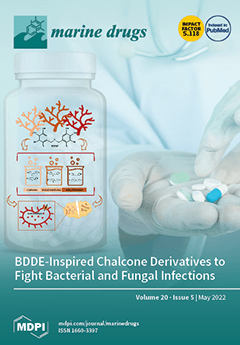For making full use of aquatic by-products to produce high value-added products, Siberian sturgeon (
Acipenser baerii) cartilages were degreased, mineralized, and separately hydrolyzed by five kinds of proteases. The collagen hydrolysate (SCH) generated by Alcalase showed the strongest 2,2-diphenyl-1-picrylhydrazyl radical (DPPH·)
[...] Read more.
For making full use of aquatic by-products to produce high value-added products, Siberian sturgeon (
Acipenser baerii) cartilages were degreased, mineralized, and separately hydrolyzed by five kinds of proteases. The collagen hydrolysate (SCH) generated by Alcalase showed the strongest 2,2-diphenyl-1-picrylhydrazyl radical (DPPH·) and hydroxide radical (HO·) scavenging activity. Subsequently, thirteen antioxidant peptides (SCP1-SCP3) were isolated from SCH, and they were identified as GPTGED, GEPGEQ, GPEGPAG, VPPQD, GLEDHA, GDRGAEG, PRGFRGPV, GEYGFE, GFIGFNG, PSVSLT, IELFPGLP, LRGEAGL, and RGEPGL with molecular weights of 574.55, 615.60, 583.60, 554.60, 640.64, 660.64, 885.04, 700.70, 710.79, 602.67, 942.12, 714.82, and 627.70 Da, respectively. GEYGFE, PSVSLT, and IELFPGLP showed the highest scavenging activity on DPPH· (EC
50: 1.27, 1.05, and 1.38 mg/mL, respectively) and HO· (EC
50: 1.16, 0.97, and 1.63 mg/mL, respectively), inhibiting capability of lipid peroxidation, and protective functions on H
2O
2-damaged plasmid DNA. More importantly, GEYGFE, PSVSLT, and IELFPGLP displayed significant cytoprotection on HUVECs against H
2O
2 injury by regulating the endogenous antioxidant enzymes of superoxide dismutase (SOD) and glutathione peroxidase (GSH-Px) to decrease the contents of reactive oxygen species (ROS) and malondialdehyde (MDA). Therefore, the research provided better technical assistance for a higher-value utilization of Siberian sturgeon cartilages and the thirteen isolated peptides—especially GEYGFE, PSVSLT, and IELFPGLP—which may serve as antioxidant additives for generating health-prone products to treat chronic diseases caused by oxidative stress.
Full article






